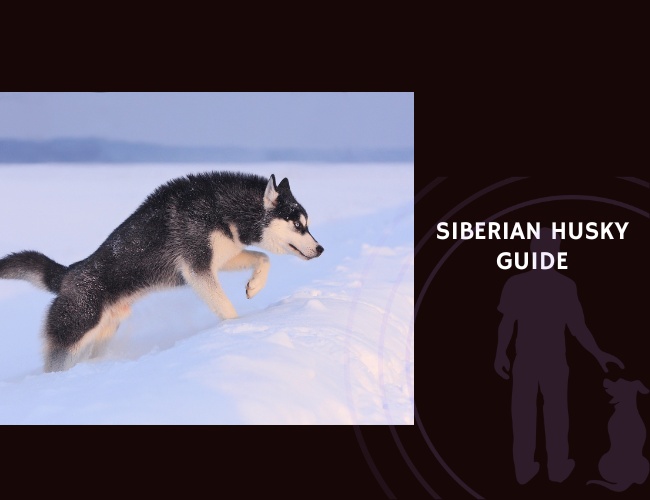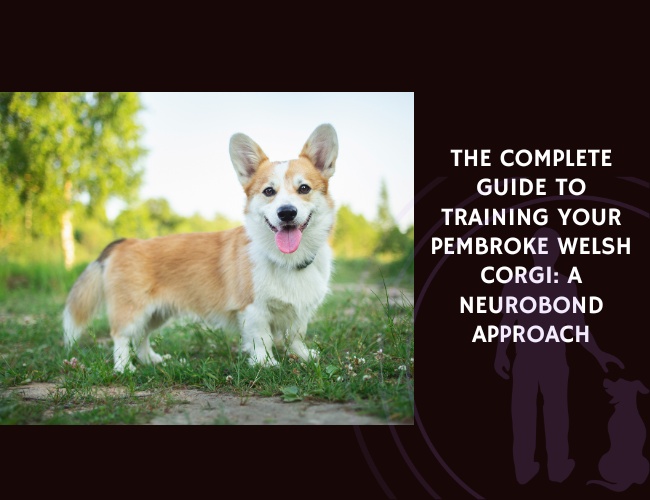Introduction to the Siberian Husky
A Look at Their Origins
The Siberian Husky traces its roots back to northeastern Asia. This energetic working dog was originally developed by the Chukchi people, who needed a canine companion with unmatched stamina and resilience. Selective breeding over generations resulted in a breed that could haul sleds for long distances through extreme Arctic conditions. That pack mentality and high endurance are still easy to see in today’s Huskies, making them both fascinating and demanding companions.
Distinctive Physical Features
Siberian Huskies are instantly recognizable. They stand out with their medium size, lean build, and classic upright ears. Their dense, double-layer coat keeps them insulated in freezing weather but also allows them to shed heat effectively when active. Their almond-shaped eyes—sometimes blue, brown, or even one of each—give Huskies an engaging and expressive look. Another trademark feature is their bushy tail, often curled over their back. You’ll also notice their impressive athleticism and light, effortless gait.
Beyond looks, Huskies are famous for their friendly expressions. They rarely look aggressive, and tend to greet both people and dogs with sociable curiosity. Don’t be fooled by the friendly appearance, though; their independence and strong prey drive require mindful handling.
What This Guide Offers
This comprehensive guide is designed to give you both informative and practical insights into living with Siberian Huskies. You’ll explore everything from their behavior and training tips to feeding, health care, and creating the ideal environment. Our content relies on scientific research and first-hand experience to help you truly understand the Siberian Husky’s unique strengths and challenges. Whether you’re a potential owner or an experienced enthusiast, this guide will support your journey to a happy, active partnership with your pup 😊.
Next, we’ll dive deeper into the unique personalities and common behaviors that make Huskies such captivating canine companions.
Character and Behavior
High stamina and pack mentality
Siberian Huskies are full of energy and love to be active! Their history as sled dogs in cold climates means they are built for endurance and working with others. You’ll notice that a Siberian Husky often prefers group play and likes to be with people or other dogs. This pack mentality gives them strong social bonds, but it can also lead to playful chasing and rowdy games. You’ll see your Husky thrive when they have company—whether it’s family, other pets, or a doggy playgroup 😊.
Independence and prey drive
Unlike some breeds, Huskies don’t always look to their humans for guidance. They have a big independent streak and can be stubborn thinkers. This trait can make training interesting, as commands could be ignored if something else is more exciting. Plus, their strong prey drive means small animals might look like chase-worthy fun. Always keep this in mind during walks or outdoor play.
The Husky’s curiosity means they have a talent for escaping from yards or enclosures that aren’t secure. Many owners find themselves surprised by how quickly a Husky can find a way out! Reliable recall is very challenging for them, so it’s smart to be extra cautious with open doors and insecure fences.
Social affability and behavioral challenges
It’s common for Huskies to be friendly with both people and other dogs. They very rarely show aggression toward humans, making them welcoming companions. However, their affectionate nature does not mean they are free from challenges. If a Husky is alone too long or doesn’t get enough activity, you might see boredom-induced behaviors like:
- Excessive vocalization (howling, barking)
- Digging up the yard or garden
- Chewing household items
- Trying to escape when left alone
These issues are often a sign they need more exercise, mental fun, or social time. The key is to keep them busy and part of the family routine.
As you grow to understand these behaviors, you’ll find ways to support your Husky’s unique personality and needs. Their independence and energy are part of what makes them so captivating!
Training Your Siberian Husky
Reward-Driven Training: Motivating the Independent Mind
Siberian Huskies are famous for their independence and intelligence. This means they need a training approach that keeps them engaged and motivated. Positive reinforcement, using treats, praise, or play, works best with this breed. Huskies respond well to rewards, so focusing on their successes helps create a positive training environment. Avoid punishment or harsh corrections—these can backfire, making your Husky lose interest or even resist training.
Consistency is vital. Short, frequent training sessions are far more effective than long, boring ones. Keep it fun and upbeat! If your Husky gets a reward for the right action, they are more likely to repeat that behavior 🦴.

Early Socialization: Building Confidence for Life
Introducing your Husky puppy to a variety of people, animals, sounds, and environments during the first few months is crucial. Early socialization helps prevent fearfulness and excessive prey drive later in life. Aim to make these experiences positive by offering treats or play during new encounters. This builds strong social skills and confidence, reducing the risk of reactivity or aggression as your Husky matures.
Here are some simple socialization steps:
- Visit parks where dogs are allowed.
- Invite friendly guests to your home.
- Take short car rides.
- Allow sniffing and gentle exploration of new places.
Leash Training and Impulse Control
Huskies are known for their love of running and chasing. Leash training is a must from an early age, as this breed is prone to pulling and getting distracted by every squirrel or bird. Use a front-clip harness and practice loose-leash walking. Reward your Husky every time they walk beside you, not when they pull.
Impulse control is equally important. Teach commands like “leave it” and “stay” using high-value treats, especially when teaching your Husky to ignore temptations. Practice in low-distraction areas first, and always increase the challenge slowly.
With patience, consistency, and the right methods, training your Husky becomes a partnership built on trust and respect 😊. This balanced approach lays the groundwork for a well-adjusted, happy companion.
Exercise and Activity Requirements
Daily Physical Needs
Siberian Huskies are well known for their exceptional stamina and high energy. To keep them happy and healthy, you need to provide at least ninety to one hundred twenty minutes of exercise every day. This time should include both brisk walks and activities where your Husky can run and explore safely. Simply letting them out in the backyard usually is not enough—structured activities make a big difference. Regular exercise helps prevent boredom, which can lead to digging, chewing, and other unwanted behaviors.
Choosing the Right Activities
Huskies shine in activities that challenge both their bodies and minds. Some owners enjoy jogging or biking with their Husky, while others participate in games like fetch or agility courses. If you have access to open spaces or trails, supervised off-leash running is a fantastic option as long as the area is secure. A tired Husky is much less likely to display destructive or escape-driven behavior 😊.
Endurance Sports for Huskies
This breed thrives in endurance-focused sports, thanks to their background as sled dogs. Consider trying:
- Canicross (running while your dog is attached to you)
- Skijoring (skiing while your dog pulls you)
- Sledding or urban mushing
These activities build on the Husky’s natural strengths, including their pack mentality and love of movement. However, always make sure your dog is physically mature before starting advanced sports to avoid injuries.
Mental Stimulation and Enrichment
Mental exercise is just as important as physical activity. Without enough challenge, Huskies become bored and may act out. Offer puzzle toys, scent work games, and interactive training sessions to engage their intelligence. Rotate toys and introduce new activities frequently to keep life interesting.
Don’t forget the value of social time with both humans and other dogs. Social play in safe, controlled environments supports emotional health, helping your Husky remain friendly and well-adjusted.
A well-exercised Husky is ready for learning and positive experiences in daily life. Building these habits ensures your companion thrives in your care and their unique needs are always met.
Wild. Loyal. Unstoppable.
A spirit bred for snow.
The Siberian Husky isn’t just built for cold—they’re born to run. Energy, endurance, and elegance all wrapped in a thick coat.
Friendly face, fierce freedom.
They may greet the world with a smile, but underneath is an escape artist with a mind of their own. Leadership isn’t optional—it’s essential.
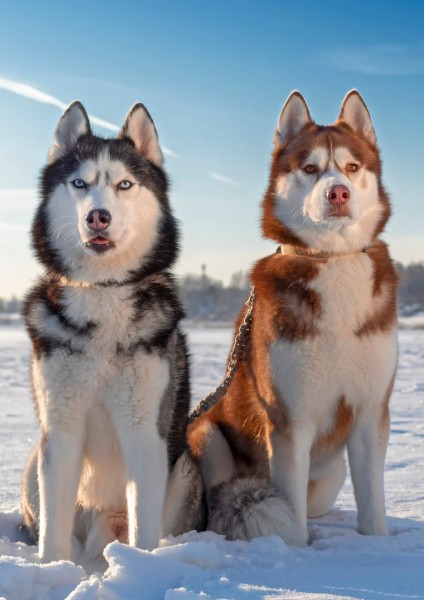
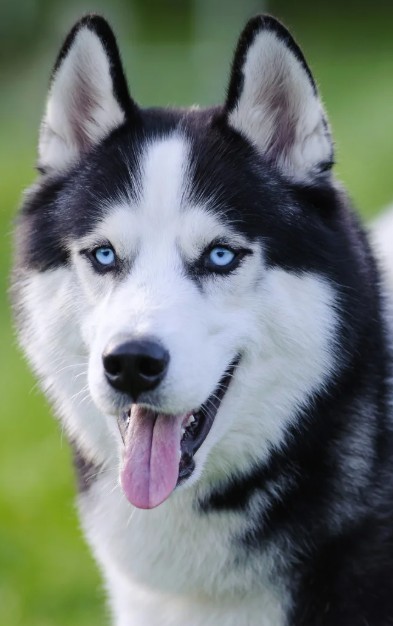
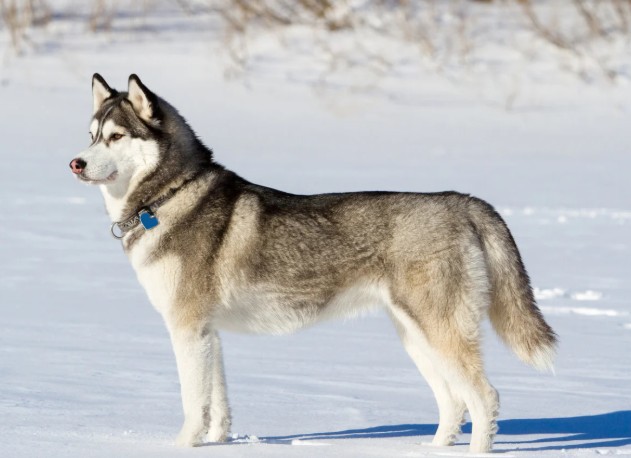
More than a pet—a purpose.
When their needs are met, Huskies reward you with unmatched loyalty and joyful companionship. But miss a step, and they’ll outsmart you with a grin.
Nutrition and Dietary Needs
Meeting High Energy Needs
Siberian Huskies are famous for their stamina and athleticism, but this means they require a diet that matches their active lifestyles. These dogs have a fast metabolism and burn energy quickly, especially if they get the recommended 90–120 minutes of daily exercise. The amount of food they need depends on how active they are. Working Huskies, especially those running or pulling sleds, need more calories than couch companions. Keeping your Husky lean helps them thermoregulate and can lower their risk of joint problems.
Building the Ideal Husky Diet
Siberian Huskies thrive on a diet high in fat and moderate in protein. This eating style mimics what their ancestors ate while working in cold climates. Fat is the main source of energy, keeping your Husky fueled for those long play sessions or runs. Protein is important for building strong muscles and maintaining overall health. Aim for food where fat provides at least half of the total calories, with protein making up a solid portion too. Avoid feeding too many grains or fillers, which don’t give much nutrition for these energetic pups.
Seasonal Adjustments and Hydration
Just like their ancestors in Siberia, modern Huskies do better when their diets match the seasons. During colder months, increase their calorie intake to help with warmth and energy. When it’s warmer, watch their hydration levels closely and encourage them to drink more water. Long wagging trails and hot playdates can lead to higher water and electrolyte needs. Consider adding water or unsalted broth to meals or carrying water on walks.
A proper diet, seasonal tweaks, and constant hydration are crucial for your Husky’s health and happiness. Up next, you’ll learn how to support your Husky’s well-being by understanding their common health challenges and how to manage them effectively.
Health Concerns and Management
Common Hereditary Conditions
Siberian Huskies are a hardy, energetic breed, but they are still prone to several hereditary health issues that responsible owners should understand.
Ophthalmic Conditions
Huskies have a genetic tendency toward several eye diseases. These include juvenile cataracts, progressive retinal atrophy (PRA), and corneal dystrophy. Regular eye exams can help catch problems early. Vision changes may not be noticeable at first, so a yearly veterinary eye checkup is essential for your husky’s lifelong comfort.
Hip Dysplasia
While not as common as in some larger breeds, hip dysplasia still occurs in Siberian Huskies. This joint issue can affect their movement and comfort. Watching for any sign of lameness and keeping your husky at a healthy weight is important. Breeders should screen for this issue to help reduce its frequency in the breed.
Other Health Concerns
Hypothyroidism
Huskies may develop hypothyroidism, a condition where the thyroid gland does not produce enough hormones. Signs include hair loss, skin problems, or reduced energy. Regular blood work can help catch this early, and treatment is available if needed.
Zinc-Responsive Dermatosis
Some Siberian Huskies show sensitivity to low zinc levels, resulting in dry, crusty skin or hair loss. Your vet can recommend nutritional changes or supplements if this occurs.
Gastric Torsion (Bloat)
This breed’s deep chest increases their risk for gastric torsion—also called bloat. It is a sudden, life-threatening condition where the stomach twists. Avoid vigorous exercise right after meals and feed smaller, more frequent meals to help keep your husky safe.
Preventative Care and Veterinary Checkups
To help your husky thrive:
- Schedule yearly vet visits for checkups, vaccinations, and early detection of problems
- Request breed-specific screenings, like eye exams and hip evaluations
- Maintain a healthy weight by following proper feeding and exercise routines
Staying proactive with your husky’s health ensures they can run, play, and keep you company for many happy years 😊. This supportive approach helps you build a lifelong bond based on trust and well-being.

Creating the Ideal Living Environment
Secure Outdoor Spaces and Fencing
Siberian Huskies are famous escape artists thanks to their high stamina and powerful prey drive. To keep your Husky safe and happy, a secure yard is a must. Fencing should be at least 180cm high and made from sturdy material. Avoid chain-link if possible—clever Huskies can climb it! Bury fencing at least 60cm underground, as many Huskies are diggers and love to escape by tunneling ⚠️. Gates should have secure latches, ideally with a lock.
An open area allows for free running and play, helping your Husky burn off energy. But always supervise—recall reliability is low, especially if birds or squirrels pass by.
Home Modifications for Comfort and Safety
Inside the home, focus on comfort without sacrificing safety. Provide soft, supportive bedding, ideally in a cool, draft-free spot. Huskies naturally prefer lying on cool tiles or floors in warmer months. Regular enrichment helps prevent boredom and destructive behaviors. Try interactive toys, puzzle feeders, and chew-safe bones.
Because Huskies can be destructive when bored, keep valuables and wires out of reach. Baby gates are useful for setting boundaries, especially when you’re out.
Temperature control is another must. Huskies have thick coats and overheat easily. In hot climates, use fans, cool mats, or air conditioning. Make sure your dog always has access to fresh water and shade 🐾.
Dealing with Different Climates
Siberian Huskies are built for cold weather but can adapt with your help. In snowy or cold climates, they’ll thrive outdoors, but should always be able to come inside. In hot weather, walk them early morning or late evening and avoid strenuous activity on hot days. Check paws for signs of heat or frostbite after walks, depending on your location.
Grooming is essential—regular brushing manages shedding, especially during seasonal coat changes. Keep up a routine year-round to control fur around the house and avoid matting.
By making thoughtful adaptations to your home and yard, you’ll support your Husky’s spirited nature and keep them safe. This foundation makes for a happy, healthy companion.
Is a Siberian Husky Right for You?
Assessing Lifestyle Compatibility
Deciding if a Siberian Husky fits your lifestyle starts with honesty about daily life and habits. These dogs need active handlers willing to commit to over ninety minutes of exercise every day. If you love running, hiking, or winter sports, that’s a definite plus! Huskies thrive in homes where humans enjoy physical activity and can provide frequent mental stimulation through enrichment like scent games or puzzle toys.
Home environment matters too. A spacious, secure yard is a must—Huskies are known for incredible escape skills. Fencing should be at least 180cm high and buried 60cm below ground. If you live in an apartment or can only provide short walks, a Husky may not be the easiest fit. They need room to run and explore safely.
Time, Space, and Financial Commitment
Huskies require significant time and attention. Beyond daily exercise, they crave social interaction—not just with you but with other dogs as well. If you work long hours away from home, a bored Husky can become destructive or develop behavior issues.
Financially, expect routine costs for quality food, veterinary care, and grooming tools for heavy seasonal shedding. Emergency medical care and preventative health checks add further expenses. Planning for these ensures your Husky remains healthy and happy throughout its twelve–fourteen year lifespan.
Considering Other Breeds
If your schedule or space is limited, or you’re looking for a dog with lower exercise and grooming needs, consider alternatives. Breeds such as the Shiba Inu or Finnish Lapphund offer many positive traits—loyalty, intelligence, and social temperament—but with lower exercise requirements and less escape tendency.
Thinking realistically about your daily routine and environment is vital before bringing a Siberian Husky into your life. Making the right choice ensures both you and your dog can thrive together. 😊
Transitioning forward, we’ll help you focus on nurturing a rewarding relationship with your four-legged friend and maintaining long-term well-being.
Conclusion: Living Successfully with Your Siberian Husky
Building a Fulfilling Bond
Living joyfully with a Siberian Husky means understanding their needs and embracing their unique qualities. These dogs have a spirited attitude, high energy, and a social heart. Daily adventures and social interaction lay the foundation for a rewarding relationship.
- Give plenty of exercise—at least 90–120 minutes every day—for a happy Husky
- Provide fun activities like scent work, puzzle toys, and group play
- Use positive reinforcement during training—treats and praise work best 😊
Through patience and consistent support, you’ll earn your Husky’s trust and respect. This strong bond makes every challenge manageable.
Lifelong Care and Health
Siberian Huskies generally live 12–14 years when their physical and emotional health is supported. Weight management is key—stay on top of portion control and keep treats healthy to avoid extra weight that can lead to joint or temperature regulation issues. Regular checkups with your veterinarian help catch any health problems early.
Keep these essentials in mind:
- Maintain a high-fat, moderate-protein diet to fuel their active lifestyle
- Ensure hydration, especially in warm weather and after exercise
- Monitor for hereditary concerns like eye disorders, hip dysplasia, and skin conditions
Grooming is a regular task—expect seasonal shedding and brush often for comfort and cleanliness.
Helpful Resources and Community Support
You are not alone in your Husky journey! Support and advice are always available through these options:
- Local Husky clubs and community groups
- Online forums and breed-specific social media pages
- Veterinary professionals who understand Husky needs
Lean on expert resources and connect with fellow owners for practical tips, encouragement, and ongoing education.
Caring for a Siberian Husky brings energy, connection, and fulfillment to your life. The strong partnership you form through compassion and consistency creates a meaningful bond—one built on trust and adventure for years to come.

